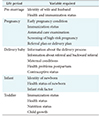1. East Java Provincial Health Office. Health profile of East Java Province in 2014. Surabaya, Indonesia: East Java Provincial Health Office;2014.
4. Steegers EA, von Dadelszen P, Duvekot JJ, Pijnenborg R. Pre-eclampsia. Lancet. 2010; 376(9741):631–644.

5. Magee LA, Helewa M, Rey E. Hypertension Guideline Committee. Strategic Training Initiative in Research in the Reproductive Health Sciences (STIRRHS) scholars. Diagnosis, evaluation, and management of the hypertensive disorders of pregnancy. J Obstet Gynaecol Can. 2008; 30:3 Suppl. S1–S2.

6. Duley L. The global impact of pre-eclampsia and eclampsia. Semin Perinatol. 2009; 33(3):130–137.

8. Evashwick C. The continuum of long-term care. 3rd ed. New York (NY): Thomson/Delmar Learning;2005.
9. Lawn J, Kerber K. Opportunities for Africa's newborns: practical data policy and programmatic support for newborn care in Africa. Cape Town, South Africa: Partnership for Maternal, Newborn and Child Health;2006. p. 24–28.
10. Buragga KA, Zaman N. Software development techniques for constructive information systems design. Hershey, PA: IGI Global;2013. p. 118–123.
11. Silver MS, Markus ML, Beath CM. The information technology interaction model: a foundation for the MBA core course. MIS Q. 1995; 19(3):361–390.

12. The Institute of Chartered Accountants of India. Information system control and audit. Nagpur, India: The Institute of Chartered Accountants of India;2015.
13. Lemke G. The software development life cycle and its application [thesis]. Ypsilanti (MI): Eastern Michigan University;2018.
14. O'Brien JA, Marakas GM. Management information systems. 10th ed. New York (NY): McGraw-Hill;2011.
15. Like P, Sahama TR, Windsor CA, Huxley C. Designing a quality health information system: case study analysis of maternal and child health in Papua New Guinea. In : Proceedings of the 51st Annual Medical Symposium - Advancing Women's Health through Innovation; 2015 Aug 30–Sep 2; Papua New Guinea.
16. Hennink MM. Focus group discussions. New York (NY): Oxford University Press;2014.
17. Lippeveld T, Sauerborn R, Bodart C. Design and implementation of health information systems. Geneva, Switzerland: World Health Organization;2000.
18. Bhattacharya M, Shahrawat R, Joon V. Understanding level of maternal and child health indicators used in Health Management Information System among peripheral level health functionaries in two districts of India. J Health Inform Dev Ctries. 2012; 6(1):385–395.
19. Ovretveit J, Nelson E, James B. Building a learning health system using clinical registers: a non-technical introduction. J Health Organ Manag. 2016; 30(7):1105–1118.

20. Soontornpipit P, Taratep C, Teerawat W, Satitvipawee P, Piroonratana T. The study of hospital information systems in the 8th health region. Procedia Comput Sci. 2016; 86:252–256.

21. McBride S, Tietze M. Nursing informatics for the advanced practice nurse: patient safety, quality, outcomes, and interprofessionalism. New York (NY): Springer Publishing Company;2016.
22. Ismail S, Alshmari M, Latif K, Ahmad HF. A granular ontology model for maternal and child health information system. J Healthc Eng. 2017; 2017:9519321.

24. Chaudhry B, Wang J, Wu S, Maglione M, Mojica W, Roth E, Morton SC, Shekelle PG. Systematic review: impact of health information technology on quality, efficiency, and costs of medical care. Ann Intern Med. 2006; 144(10):742–752.








 PDF
PDF ePub
ePub Citation
Citation Print
Print






 XML Download
XML Download